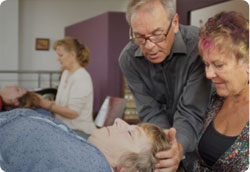This gentle manual massage therapy uses slow interactive pressure and stretch techniques to assess and release restrictions of connective tissue in the whole body, including the head. The name Craniofascial Therapy (CFT) was coined in 1992, condensing myofascial release and craniosacral therapy into one term, to better describe the fascial nature of restrictions and release, including the head. Principles and techniques are derived from applied anatomy, giving the therapist a tangible tactile appreciation of body issues.

Fascia
Also called fascia, connective tissue is distributed in particular ways. In the body, each muscle is wrapped in fascia in three descending levels, In the head, a membrane system inside the skull called the meninges interconnects with the cranial vault bones. A craniosacral mobility restriction in one part may migrate to adjacent areas, affecting their function also.
Connective tissue present in the sutures between the cranial bones allows for slight but definite mobility. It is the release of these abnormal tensions of connective tissues that treats the cause of symptoms, by a repositioning of distorted cranial structures, restoring normal balanced tension to the organs, nerves, blood vessels and other structures within.
Cranial rhythm
The body movements of the cranial rhythm can be used to assess and release patterns of restriction. Discovered by the American osteopath William Sutherland, 1872-1954, this mechanism creates movement without muscular action. The effects of this involuntary, cyclical body movement phenomenon can be used to both assess restrictions and also recruited as an internal force to assist with the release of those restrictions. The still point technique derives from this remarkable approach and is worthy of a wider audience.
 Dysfunctional patterns of biomechanical tension, commonly resulting from impaired posture and injuries, are perpetuated in the body by fascial mobility restrictions, found at local and systemic levels through palpation. As fascia becomes restricted, the body loses suppleness and function in the affected structures.The therapist releases these restrictions with progressive, gentle forces in an interactive way. Tissue mobility is further assessed by interpreting the slow pulsations of the cranial rhythm throughout the body, and modified by appropriate use of the therapist’s hands, like gears applied to a motor.
Dysfunctional patterns of biomechanical tension, commonly resulting from impaired posture and injuries, are perpetuated in the body by fascial mobility restrictions, found at local and systemic levels through palpation. As fascia becomes restricted, the body loses suppleness and function in the affected structures.The therapist releases these restrictions with progressive, gentle forces in an interactive way. Tissue mobility is further assessed by interpreting the slow pulsations of the cranial rhythm throughout the body, and modified by appropriate use of the therapist’s hands, like gears applied to a motor.
Different to massage
Therapists expand the range of their existing palpation skills, through sensing and responding to the pattern of restriction and mobility present in the body, as they practise CFT. There is no oil or pushing or rubbing. Your hands stay at their contact locations for each technique. For many massage therapists who learn CFT this represents an entirely new way to understand and work with the body.
Cranial restrictions can directly cause symptoms and tend to persist without appropriate local and systemic treatment. Elderly, infant and acute cases are particularly amenable to this subtle treatment as CFT does not elicit a protective guarding response.
Headache and other symptoms
In the body, chronic and acute tension and stiffness, pain, neck stiffness, lower backache etc respond favourably. In the head, many syndromes are potentially amenable to successful treatment, such as head pain, tinnitus, recurrent ear infections, voice and taste problems, vertigo, sinusitis, jaw and TMJ dysfunction etc .
CFT is highly effective as a stand-alone or adjunct therapy in the majority of cases, as tight restricted fascia is a common adverse clinical finding. See Benefits of Craniofascial Therapy for more information on symptoms suitable for treatment with craniosacral.

